Decembrist: features and homeland of a houseplant
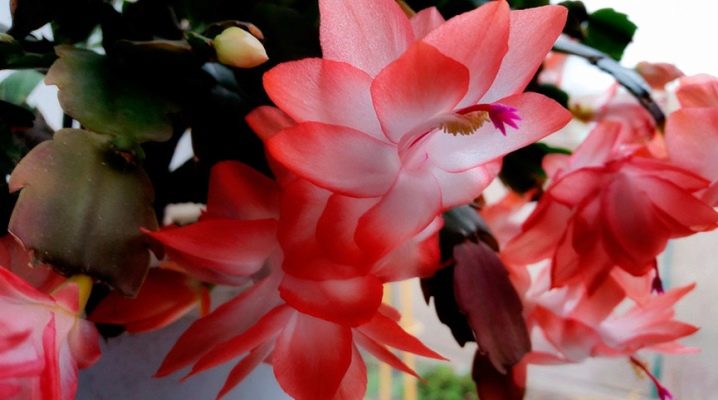
In the yard there are bitter frosts, and on the window, in spite of winter, a favorite, the Decembrist, is blooming magnificently. How a wonderful flower came to us, where is its homeland, what are the features of growing a plant, why it blooms in winter, read in this article.
Description
The Decembrist, who is also a Christmas tree, zygocactus, zygocerius and Schlumberger's cactus, conquered flower lovers with its unpretentiousness and the ability to bloom magnificently in winter, when a dormant period begins for most domestic plants. The plant belongs to the genus of epiphytic cacti, but does not have needles and bulky fleshy stems. The total height of the bush is up to 50 cm. The creeping shoots are dense and flat, consisting of separate leaves, passing from one to another, outwardly resemble a girl's braids.
Zygocactus flowers open in winter at the ends of the shoots. The inflorescences are quite large - from 6 to 8 cm in length. They have the shape of elongated phonographs, consisting of several tiers. The flower stamens coquettishly look out, their smell is weakly expressed, and the colors are bright and attractive: crimson, purple-red, pink, cream, purple. Inflorescences bloom alternately within a month, but do not live long - from 3 to 5 days.
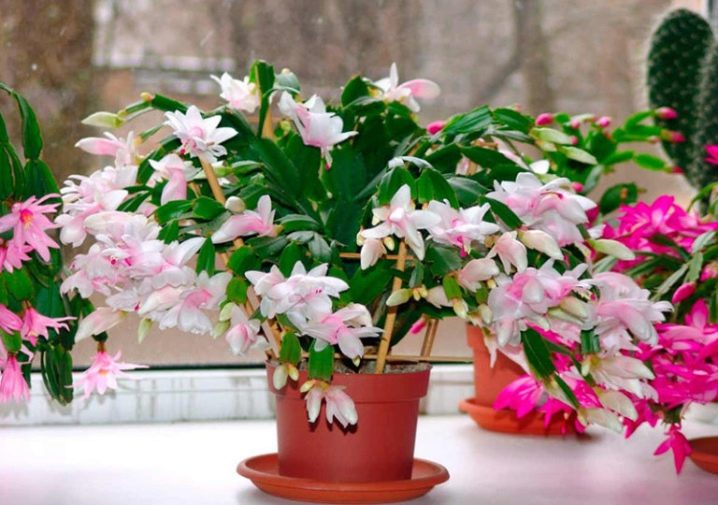
Popular varieties
Truncated zygocactus has such characteristics as:
- leaves long - from 4 to 6 cm;
- escapes have pronounced teeth;
- top of the sheet looks truncated;
- flowers there are salmon, raspberry, purple flowers.
Kautsky's zygocactus has the following features:
- small leaves - up to 3.5 cm in length;
- narrow shoots - no more than 15 mm;
- flowers are pale purple, star-shaped with sharp petals.
Zygocactus Russeliana attracts attention with such features as:
- shoots of small length - up to 4 cm;
- the total height of the plant is not higher than 30 cm;
- there are no needles or teeth around the edges;
- flowers up to 5 cm in diameter, bright pink with sharp, widely spaced petals;
- white stamens are visible from the middle.
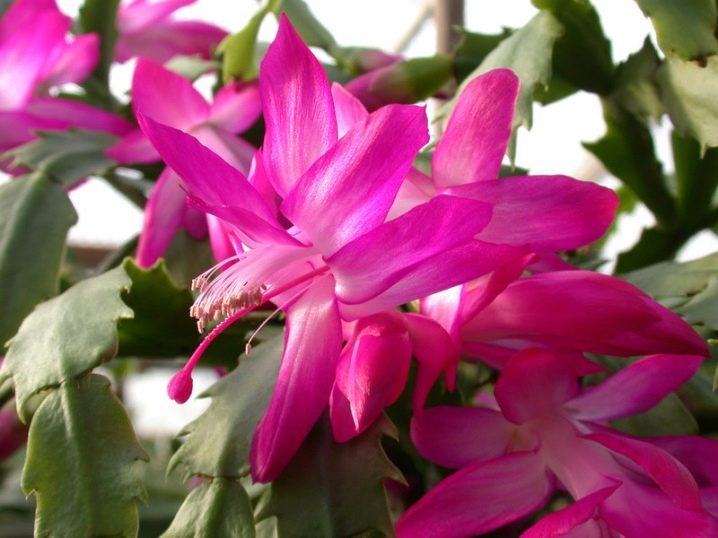
Decembrist Schlumberger Gertner has the following distinctive features:
- shoots are fleshy and large;
- leaves are wide, without chipping;
- flowers are large, rich bright red with sharp petals;
- greens are glossy, bright green.
Zygocactus hybrid varieties look unusually beautiful. These include the following:
- Golden Cream has large flowers of delicate light shades: from pale cream to light golden;
- at Aspen fragile double petals, white as snow, shaped like a carnation;
- Madame Butterfly with leaves that have white or purple segments and boiling white petals resembling a butterfly in shape with a bright purple edging;
- Santa cruz - This is a luxurious plant with a salmon color;
- Cambridge Is a plant with delightful matte pink, rounded petals.

Homeland of the Decembrist
The birthplace of a Christmas tree who gives us a magical bloom in the coldest time of the year, in faraway South America, or rather in Brazil. This is an amazing country where not only "wild monkeys" live. European scientists and researchers who went there in the 19th century were amazed at the diversity of flora and fauna of this corner of the planet and made many wonderful discoveries here.Decembrist thickets were discovered by travelers in the southeast of Brazil in the high-mountain forests in the São Paulo region.
English scientist-botanist Allan Cunningham, collecting a collection of unique plants, took the Decembrist to Europe. The French breeder Frederic Schlumberger, who became interested in an amazing plant, proved that the flower belongs to the cactus family. The botanist Charles Lemaire, dedicated to the study of cacti and succulents, named the flower after his colleague the Schlumbergeg cactus.
Gradually, the flower spread through the botanical gardens of Europe, and then became a resident of ordinary houses and apartments, decorating them with its lush bloom on Christmas Eve. This explains its origin: at this time in Brazil it is the very height of summer.
The Schlumberger cactus, like all plants, has a unique genetic memory and blooms when it is time to bloom in its distant homeland.

How does it grow in wildlife?
In the impenetrable alpine forests at an altitude of more than 900 m, where each plant stubbornly fights for its survival, the Decembrist won a place for itself in the upper tier of the tropical jungle. Here the Christmas tree feels at ease, settling on snags in the crevices and cracks of powerful trunks. It is quite enough for the light passing through the crowns of tall tropical trees, nutrients from decomposed organic matter, moisture that it accumulates in stems and leaves during seasonal rains. Having taken root in the wood, the zygocactus descends its stems. Their length can be up to 1.5 meters.
Segments of shoots that have accidentally broken off quickly take root and, clinging to a support, give life to new specimens. So the plant spreads, occupying very large areas. The habitat made him hardy. Zygocactus tolerates temporary cold snaps and periods of drought very persistently, and its root system survives even among bare stones.
Decembrist bloom begins in mid-November and ends at the end of January. Crimson-red flowers open at the ends of the shoots drooping from tall trees. This enchanting spectacle amazes people with its beauty and attracts birds. The flower is characterized by cross-pollination. Baby hummingbirds and hawk moths, captivated by the beauty of flowers, do an excellent job with this task. For this, nature has endowed the zygocactus with the shape of flowers elongated like a tube.
The fruits of the plant are formed within a month. They are pear-shaped, no more than 2 cm long, are bright orange or red and have a pleasant sour taste. Birds and animals enjoy them with pleasure, and then carry them with excrement through the forest. Seeds often sprout directly in overripe fruits. The berry, falling to the ground, begins to rot. Using its pulp as a nutrient substrate, a new plant develops inside. This is how the cactus successfully fights for survival in the wild. The lifespan of a plant in freedom is more than 50 years.
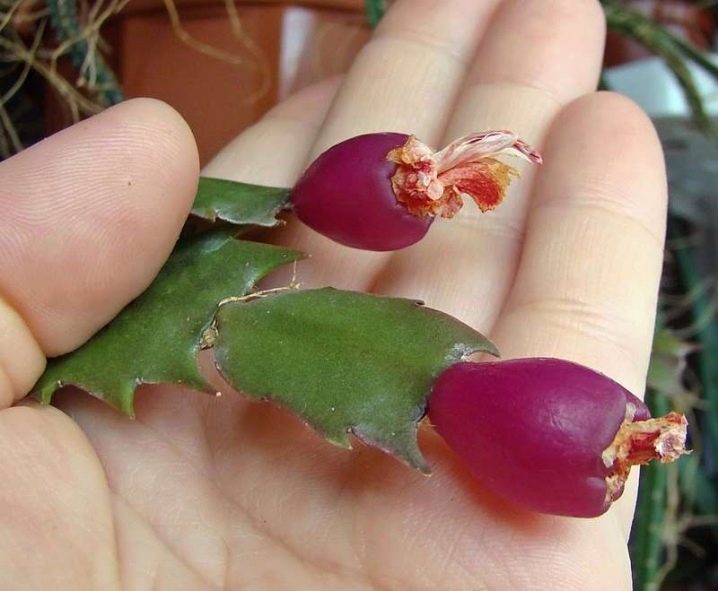
Growing conditions at home
A guest from distant overseas countries is completely unpretentious in leaving. It does not require special substrates, fertilizers, additional lighting or complex manipulations on itself. It is enough to create conditions close to the natural habitat for the indoor zygocactus.
Lighting
The Decembrist, born under the canopy of a subtropical forest, does not like bright light. Direct sunlight is dangerous for a plant accustomed to diffused lighting, therefore, southern windows for zygocactus are contraindicated. You can place the flower in the back of the southern room where there is shading.
North and west windows are perfect for the plant.
Temperature
In the subtropics, it is warm all year round, so the comfortable temperature for zygocactus in spring and summer is not higher than + 25 ° C. From August to the end of November, the flower retires to gain strength for future flowering. It is necessary to transfer it to a darker and cooler place with a temperature of +10 to +20 degrees.In December, when summer hits the Southern Hemisphere, the plant will begin to bloom. It is necessary to rearrange it again in a well-lit and warm place before flowering.
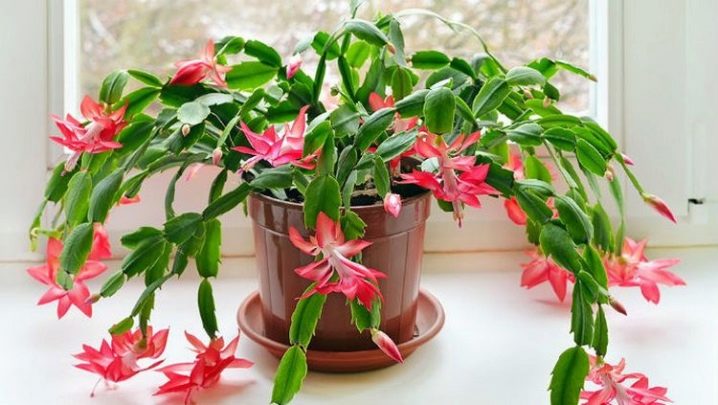
Important! During the emergence of buds, the plant cannot be carried or turned. Zygocactus in protest can shed all the buds and deprive you of the opportunity to see the wonderful bloom.
Watering and moisturizing
The Decembrist loves moisture, but in moderation. The soil in the pot should not be wet, but it cannot be brought to complete drying of the soil. As soon as the substrate dries up from above, it is time to water the flower moderately with warm, settled water. Each period of the life of a zygocactus is characterized by its own watering regime, namely:
- during flowering, watering increases, phosphorus-potassium fertilizers are added to the water;
- when the plant is preparing for flowering, top dressing is suitable no more than 1 time per week with fertilizers for cacti;
- during the dormant period, watering is reduced, the Decembrist is not fertilized.
Zygocactus love spraying with water from a spray bottle, especially during the heating season, and in the warm season they will happily take bathing in the shower. During the procedure, it is important to hermetically cover the soil in the pot with oilcloth so that no water gets there.
Important! When watering a flower, do not forget to empty the pan of the pot from excess water after a while, otherwise this will lead to rotting of the plant roots.
Formation
Descending shoots of the Decembrist look great in hanging pots. In order for the plant to have a beautiful symmetrical shape and give many shoots, the zygocactus bush is given the correct shape by pinching, like in any ampelous plants. In order not to harm the flower, you must do it correctly, adhering to the following algorithm of actions:
- pinching the zygocactus is possible only after flowering;
- it is impossible to cut off or cut off segments of the Decembrist's shoots with scissors;
- hold the shoot with the thumb and forefinger of one hand, and with the fingers of the other, gently unscrew the selected segment from the stem.
After plucking, the bush will become more spreading, lush and bloom more profusely. The procedure not only makes the Decembrist attractive, but also rejuvenates, prolonging his life. A well-groomed zygocactus at home is a long-liver that lives for more than 20 years. Skilled flower growers with extensive experience in growing cacti create whole masterpieces, forming a standard bush from a Decembrist: cuttings of a zygocactus are grafted onto a pereskia cactus stem, from which the top is cut off.
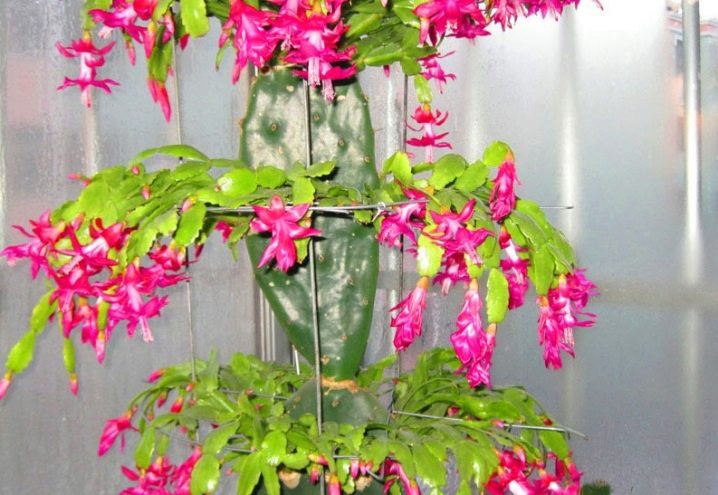
Landing
Decembrist has a poorly developed and weak root system. Plant pots are suitable for ceramic, wide and shallow. The soil for the Decembrist should be nutritious, loose. Water should not linger in it, since in nature epiphytes live in a dry environment. Mosses, pieces of bark, wood, on which the zygocactus grows, gradually decompose, creating an acidic environment. The same acidity - pH 5.5 should have the land in which the Decembrist is planted at home.
The composition of the soil should be as follows:
- garden land - 1 part;
- compost - 1 part;
- river sand - 1 part;
- sour peat - 1 part;
- charcoal - 1 part.
Instead of sand, you can take vermiculite for looseness. Pieces of moss or pine bark, as well as activated carbon, will help maintain the correct moisture level in the substrate. Suitable for planting and ready-made soil for cacti, purchased in the store. Good drainage, which does not allow moisture to stagnate in the soil, should occupy 1/3 of the volume of the pot. When replanting a plant, you should not take a pot much larger than the previous one. Until the roots take up the entire volume of the container, the zygocactus will not bloom.
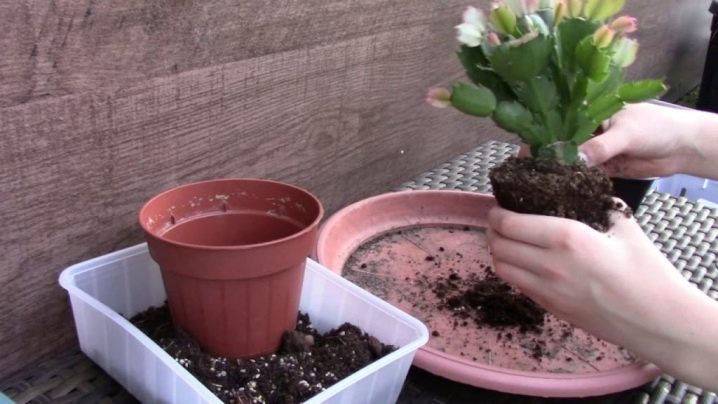
Important! Young plants are transplanted every year - adults 1 time in 3 years. The ideal time to transplant is after flowering ends.
Reproduction
The most common way is to propagate the Decembrist by cuttings. You can root them in water or wet soil. For rooting in soil, follow these steps:
- separate cuttings containing 3 fragments from healthy shoots by twisting;
- so that the wound formed on the handle heals, leave the cut fragment for a day in a shaded place;
- prepare wet soil, sand or coco peat for planting;
- make a small depression in the substrate and place the shoot in it;
- the plant takes root after 3 weeks, when young leaves appear on it.
To root the cuttings in water, it is worth following steps such as:
- put the prepared stalk into a glass with filtered, settled water;
- in order to avoid decay of the plant in water, you need to add a piece of charcoal or several activated tablets - 2-3 pieces per 250 g of water;
- change the water every week;
- after the appearance of roots, but not less than a month later, the plant is planted in new soil;
- cutting off the cuttings during the flowering period is not recommended.

Important! You can propagate the Decembrist using seeds or grafting, but only experienced breeders can achieve success in this.
Diseases
It is worth considering the most common plant diseases.
- Late blight Is a fungal disease that causes plant decay and death. Signs: brown and gray spots on the shoots that resemble mold. Treatment: treatment with fungicides "Maxim" and "Vitaros".
- Fusarium Is a fungal disease that affects the vessels and root system of a plant. Signs: the plant becomes lethargic, turns yellow and withers before our eyes. Fusarium cannot be treated, it is necessary to destroy it so as not to infect other specimens.
Zygocactus suffers from the following pests:
- whitefly;
- mealybug;
- shield.
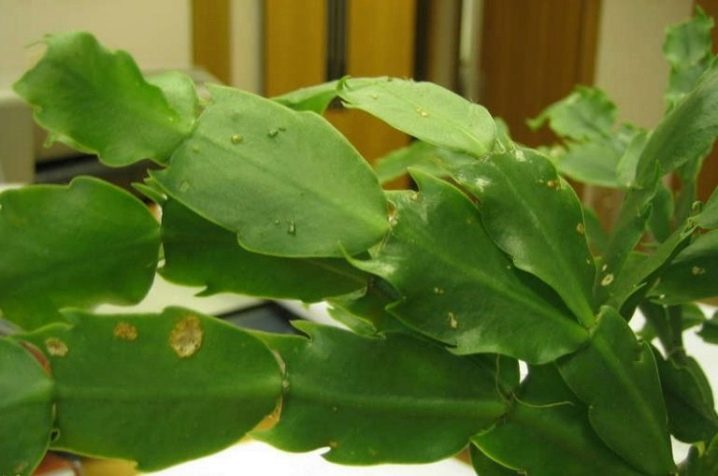
To get rid of pests, wash the plant thoroughly with green soap, and then treat with such special preparations as:
- "Aktelik" to combat whitefly;
- "Tanker" or a solution of karbofos from the scabbard;
- "Aktar" for the destruction of mealybug.
By observing the following preventive measures, you can prevent diseases and keep the Decembrist healthy:
- disinfect the soil before planting by calcining or pouring boiling water;
- water the plant with warm, settled water;
- do not allow the earthen coma to become waterlogged or completely dry;
- pick off yellow leaves in time, remove fallen ones;
- do not allow the temperature in the room below +10 degrees;
- if you suspect fungal infections, treat the zygocactus with Mikol;
- washing and spraying the flower will help against the appearance of pests;
- be attentive to the plant - and it will certainly delight you with a fabulous bloom.
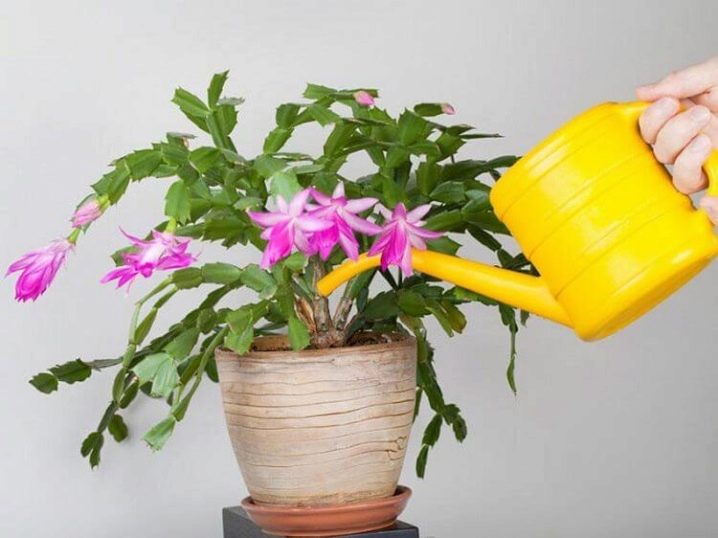























































The comment was sent successfully.